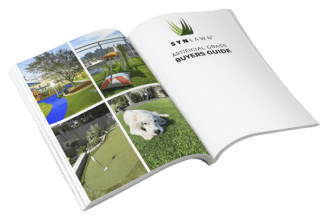Artificial lawns have quickly become one of the preferred methods for achieving a picturesque landscape for many residential and commercial property owners. Synthetic turf offers many environmental and financial benefits including reduced water consumption, minimal time and energy expended on lawn maintenance, and a lush, green lawn year-round.
If you choose to invest in artificial turf, you’ll have the option to either hire a professional or to complete a DIY artificial turf installation. Choosing to install turf yourself can make artificial lawns more affordable, but you run the risk of installing the turf improperly and potentially ruining your investment.
When deciding whether to hire a professional or to complete a DIY artificial turf installation, you should consider your own landscaping skills, the time and energy you can dedicate to this project and the specific conditions of your yard. Both DIY artificial turf installation and professional turf installation have their benefits, so it’s important to account for the unique factors of your situation when making your decision.
How Much Does Professional Turf Installation Cost?
Typically, an experienced turf installer charges between $8-$12 per-square-foot and take a two-thirds commission of that price. Here at SYNLawn® Houston, our professional installation crews are highly experienced and our entire team focuses on installing the absolute best solution for your artificial grass needs. Our 30 different synthetic versions of grass styles pay for themselves in just a few years’ time and can pay themselves off even sooner if you choose to do a DIY artificial turf installation.
You can save about $5-$8 per-square-foot on labor and install your turf yourself for around $3-$4 per square foot, which is about the same cost as installing a natural sod lawn. Installing artificial turf is not an elaborate process, but it is very labor-intensive, so if you choose to do so, get ready to roll up your sleeves and put in some elbow grease!
Should I Hire a Professional?
To determine if you can install artificial grass yourself or if you should hire a professional, you’ll need to assess your skills and circumstances. The three biggest factors to take into account when making your decision are the size of your yard, the condition of the soil, and the resources you have available.
Yard Size
Depending on the size of the area you’d like to place it in, you may want to hire a professional to install your artificial turf. Small areas like pet turf and putting greens can be easily managed by amateur handymen, while large areas like residential yards or playgrounds require more grass, which naturally makes it a more time-consuming and labor-intensive undertaking. Larger areas also require more seaming, which can be a difficult process for inexperienced landscapers.
Seaming is the process of linking two or more cuts of turf together. The seams between each cut should be undetectable to achieve a natural-looking lawn. If you’re an amateur landscaper, the more cuts you have to seam, the more likely you are to make a mistake and end up with an uneven lawn.
If you have a smaller yard that won’t require as much seaming, DIY artificial turf installation may be a good option for you, but if you believe your yard requires a lot of seaming, the extra expense of hiring a qualified professional may be a worthwhile investment.
Difficult Soil
The condition of your soil also determines whether DIY artificial turf installation is a viable option for you. In order to properly install artificial turf, the soil must be excavated at least 3 in. deep. Soil that is thick, rocky, or heavily rooted in the ground is very difficult to work with and digging it up can be very physically demanding. You may also find irrigation lines, tree roots, and other obstacles that can hinder excavation.
If you find that the soil in your lawn has any of these characteristics and you don’t feel equipped to handle the manual labor it requires to remove it, a professional contractor may be your best bet.
Time
Synthetic turf has been dubbed as the “Instant Lawn” however if you decide to do DIY artificial turf installation, this nickname won’t apply.
On average, professional artificial grass installations take about 1-3 days to install depending on the size of the worksite. For areas between 300-500 square feet, installation can usually be completed within a day. For larger yards of 1000 square feet or more, artificial lawns usually take 3 days to install. While this may not seem like a huge time commitment, this is the time it requires for seasoned professionals working 8-10 hour days to install a full artificial lawn, so it totals to roughly 8-30 hours of labor.
If you plan to take the DIY route, you’ll likely need to double that time to account for inexperience. You’ll also need to consider if you’re going to take off work to complete the project or if you’ll complete the install during your free time.
The reality is there are some jobs that are better handled by professionals. If spending your next few weekends with a shovel and some dirt doesn’t sound all that appealing to you, a professional installer can have your “Instant Lawn” ready in a few days’ time. Alternatively, if you have the time, resources and skill to install your own turf, you can save money while getting some serious muscle tone.

How To DIY Artificial Turf Installation
If after assessing your current situation you determine that you’re capable of installing artificial turf yourself, you’ll need to understand the process to complete your project. DIY artificial turf installation can be completed in the following 10 steps:
Step 1: Site Walk
First, you’ll need to survey the area and surroundings of the worksite you’d like to place turf in. Assess the condition of the soil, clear the worksite of debris, and create an unobstructed pathway to the area.
Step 2: Excavation
Dig up the surface soil in your entire work site to a depth of at least 3 inches. During this time you can also make changes to irrigation, drainage or other underground obstacles. ]
Step 3: Build Base
You need to create a smooth surface with defined edges for your turf to be laid on. To do this, fill the excavated area with a class-2 road base or similar sub-base that is approximately 3-4 inches deep, then use a vibratory plate compactor to compact the base. Leave a ¾ in. space between the base and hardscape edge and use a hand tamper to compact hard-to-reach edges and corners.
Step 4: Measure, Cut and Lay Grass
Once your base is built, roll out your turf and let it rest in the sun for at least one hour to soften it in order to make cutting and installing easier. If your project requires seaming, start by measuring and cutting the largest piece first with a carpet cutter or razor knife. Here are some tips for cutting your turf properly:
- Make sure that the blade direction and stitch patterns are facing the same way to avoid an uneven appearance.
- Make all cuts on the back of synthetic grass so you can see the stitch rows.
- Leave 1/4 in. to 1/2 in. of turf over the edge of your border.
Once your turf is cut into the correct shapes, carefully place your artificial grass into the proper position. We recommend wearing knee pads to protect your knees and shins while manipulating the turf.
Step 5: Seaming
If your installation requires seaming, you’ll need to use seam tape and glue to attach the pieces together. Place the red line of your seam tape down the center of the seam between each piece of turf and make an “S” pattern with your glue on top of the seam tape. Move turf into place and let the glue set for 15 minutes. Brush the blades of your turf so they are laying in the same direction when seaming and make sure that the distance between each stitch row matches to achieve an invisible seam.
Step 6: Secure the Perimeter
Once your turf is measured, cut, seamed, and laid, you can secure the edges of your lawn to lock it into place. Begin by tucking the ¼ in. to ½ in. the edge you left on the border into the surrounding hardscape with a hammer and chisel. Use 5 in., non-galvanized nails or staples every 3-6 inches around the perimeter as well as every 3 square feet within the interior to secure the turf. Spread the blades when nailing so no fibers are caught under the nail head.
Step 7: Infill and Finishing Touches
Now that the grass is laid out and attached, it’s time to place the infill. The turf system you have purchased has specific infill requirements and following them is a key factor in the appearance, performance, and life span of your artificial lawn. Once you’ve spoken to your SYNLawn representative to determine the correct infill, use a drop spreader to evenly spread 1-2 lbs of infill per square foot. Then, use a power broom or stiff-bristled broom to brush the infill and blades in order to achieve a natural, freshly-mowed look. Now, enjoy your brand new artificial lawn and give yourself a pat on the back for all your hard work!
What’s Right for You?
Deciding whether to hire a professional contractor or to DIY artificial turf installation is a huge factor when it comes to budgeting for your artificial lawn. Both options have their own benefits and drawbacks, so it’s important to be honest with yourself and objectively assess your situation.
We’re more than happy to help you make your decision so please visit your local SYNLawn store or give us a call at 888.507.TURF if you have any questions regarding artificial turf installation.

